Lantus and Lantus SoloStar
Generic name: Insulin Glargine (U-300) Pens
Brand names: Lantus Solostar, Toujeo Max SoloStar, Toujeo
Drug class: Insulin
Medically reviewed by A Ras MD.
What is Lantus?
Lantus is a long-acting man-made insulin used to control high blood sugar in adults with diabetes mellitus.
- Lantus is not for use to treat diabetic ketoacidosis.
- It is not known if Lantus is safe and effective in children less than 6 years of age with type 1 diabetes.
- It is not known if Lantus is safe and effective in children with type 2 diabetes.
What is the most important information I should know about Lantus?
Do not share your syringes with other people, even if the needle has been changed. You may give other people a serious infection, or get a serious infection from them.
Do not share your Lantus SoloStar pen with other people, even if the needle has been changed. You may give other people a serious infection, or get a serious infection from them.
Who should not use Lantus?
Do not use Lantus if you:
- are having an episode of low blood sugar (hypoglycemia).
- have an allergy to insulin glargine or any of the ingredients in Lantus. See the end of this Patient Information guide for a complete list of ingredients in Lantus.
What should I tell my healthcare provider before using Lantus?
Before using Lantus, tell your healthcare provider about all your medical conditions including if you:
- have liver or kidney problems.
- take other medicines, especially ones called TZDs (thiazolidinediones).
- have heart failure or other heart problems. If you have heart failure, it may get worse while you take TZDs with Lantus.
- are pregnant, planning to become pregnant, or are breastfeeding. It is not known if Lantus may harm your unborn baby or breastfeeding baby.
Tell your healthcare provider about all the medicines you take including prescription and over-the-counter medicines, vitamins, and herbal supplements.
Before you start using Lantus, talk to your healthcare provider about low blood sugar and how to manage it.
How should I use Lantus?
- Read the detailed Instructions for Use that come with your Lantus insulin or your Lantus SoloStar single-patient-use pen.
- Use Lantus exactly as your healthcare provider tells you to. Your healthcare provider should tell you how much Lantus to use and when to use it.
- Know the amount of Lantus you use. Do not change the amount of Lantus you use unless your healthcare provider tells you to.
- Check your insulin label each time you give your injection to make sure you are using the correct insulin.
- Lantus comes in a SoloStar single-patient-use prefilled pen that you must use to give your Lantus. The dose counter on your pen shows your dose of Lantus. Do not make any dose changes unless your healthcare provider tells you to.
- Do not use a syringe to remove Lantus from your SoloStar disposable prefilled pen.
- Do not re-use needles. Always use a new needle for each injection. Re-use of needles increases your risk of having blocked needles, which may cause you to get the wrong dose of Lantus. Using a new needle for each injection lowers your risk of getting an infection.
- You may take Lantus at any time during the day but you must take it at the same time every day.
- Only use Lantus that is clear and colorless. If your Lantus is cloudy or slightly colored, return it to your pharmacy for a replacement.
- Lantus is injected under the skin (subcutaneously) of your upper legs (thighs), upper arms, or stomach area (abdomen).
- Do not use Lantus in an insulin pump or inject Lantus into your vein (intravenously).
- Change (rotate) injection sites within the area you chose with each dose to reduce your risk of getting lipodystrophy (pits in skin or thickened skin) and localized cutaneous amyloidosis (skin with lumps) at the injection sites.
- Do not use the exact same spot for each injection.
- Do not inject where the skin has pits, is thickened, or has lumps.
- Do not inject where the skin is tender, bruised, scaly or hard, or into scars or damaged skin.
- Do not mix Lantus with any other type of insulin or liquid medicine.
- Check your blood sugar levels. Ask your healthcare provider what your blood sugar should be and when you should check your blood sugar levels.
Keep Lantus and all medicines out of the reach of children.
Your dose of Lantus may need to change because of:
- a change in level of physical activity or exercise, weight gain or loss, increased stress, illness, change in diet, or because of the medicines you take.
What should I avoid while taking Lantus?
While using Lantus do not:
- drive or operate heavy machinery, until you know how Lantus affects you.
- drink alcohol or use over-the-counter medicines that contain alcohol.
What are the possible side effects of Lantus and other insulins?
Lantus may cause serious side effects that can lead to death, including:
- Low blood sugar (hypoglycemia). Signs and symptoms that may indicate low blood sugar include:
- dizziness or light-headedness, sweating, confusion, headache, blurred vision, slurred speech, shakiness, fast heartbeat, anxiety, irritability or mood change, hunger.
- Severe allergic reaction (whole body reaction). Get medical help right away if you have any of these signs or symptoms of a severe allergic reaction:
- a rash over your whole body, trouble breathing, a fast heartbeat, or sweating
- Low potassium in your blood (hypokalemia).
- Heart failure. Taking certain diabetes pills called TZDs (thiazolidinediones) with Lantus may cause heart failure in some people. This can happen even if you have never had heart failure or heart problems before. If you already have heart failure it may get worse while you take TZDs with Lantus. Your healthcare provider should monitor you closely while you are taking TZDs with Lantus. Tell your healthcare provider if you have any new or worse symptoms of heart failure including:
- shortness of breath, swelling of your ankles or feet, sudden weight gain.
Treatment with TZDs and Lantus may need to be changed or stopped by your healthcare provider if you have new or worse heart failure.
Get emergency medical help if you have:
- trouble breathing; shortness of breath; fast heartbeat; swelling of your face, tongue, or throat; sweating; extreme drowsiness; dizziness; confusion.
The most common side effects of Lantus include:
- low blood sugar (hypoglycemia), weight gain, allergic reactions, including reactions at your injection site, skin thickening or pits at the injection site (lipodystrophy)
These are not all the possible side effects of Lantus. Call your doctor for medical advice about side effects. You may report side effects to FDA at 1-800-FDA-1088.
Drug Interactions
A total of 376 medications are known to interact with Lantus and Lantus SoloStar. Use the Interactions Checker Tool.
Common Interactions Checks
- amlodipine
- aspirin
- atorvastatin
- furosemide
- gabapentin
- Humalog
- lisinopril
- metformin
- Novolog
- omeprazole
- simvastatin
- Vitamin D3
General information about the safe and effective use of Lantus
Medicines are sometimes prescribed for purposes other than those listed in a Patient Information leaflet. Do not use Lantus for a condition for which it was not prescribed. Do not give Lantus to other people, even if they have the same symptoms that you have. It may harm them.
This Patient Information guide summarizes the most important information about Lantus. If you would like more information, talk with your healthcare provider. You can ask your pharmacist or healthcare provider for information about Lantus that is written for healthcare professionals. For more information about Lantus call 1-800-633-1610 or go to the website www.lantus.com.
How should I store Lantus?
Lantus 10 mL vial:
- Store unused Lantus vials in the refrigerator between 36°F to 46°F (2°C to 8°C).
- Store in-use (opened) Lantus vials in a refrigerator or at room temperature below 86°F (30°C).
- Do not freeze Lantus.
- Keep Lantus out of direct heat and light.
- If a vial has been frozen or overheated, throw it away.
- The Lantus vials you are using should be thrown away after 28 days, even if it still has insulin left in it.
Lantus SoloStar Single-Patient-Use Prefilled Pen:
- Please check the leaflet for the insulin for complete instructions on how to store SoloStar.
- If your SoloStar is in cool storage, take it out 1 to 2 hours before you inject to allow it to warm up. Cold insulin is more painful to inject.
- Keep SoloStar out of the reach and sight of children.
- Keep your SoloStar in cool storage (36°F–46°F [2°C–8°C]) until first use. Do not allow it to freeze. Do not put it next to the freezer compartment of your refrigerator or next to a freezer pack.
- Once you take your SoloStar out of cool storage, for use or as a spare, you can use it for up to 28 days. During this time it can be safely kept at room temperature up to 86°F (30°C). Do not use it after this time.
- SoloStar in use must not be stored in a refrigerator.
- Do not use SoloStar after the expiration date printed on the label of the pen or on the carton.
- Protect SoloStar from light.
- Discard your used SoloStar as required by your local authorities.
- Maintenance:
- Protect your SoloStar from dust and dirt.
- You can clean the outside of your SoloStar by wiping it with a damp cloth.
- Do not soak, wash, or lubricate the pen as this may damage it.
- Your SoloStar is designed to work accurately and safely. It should be handled with care. Avoid situations where SoloStar might be damaged. If you are concerned that your SoloStar may be damaged, use a new one.
What are the ingredients in Lantus?
Active ingredient: insulin glargine
Inactive ingredients:
10 mL vial: zinc, m-cresol, glycerol, polysorbate, and water for injection
3 mL SoloStar prefilled pen: zinc, m-cresol, glycerol, and water for injection. Hydrochloric acid and sodium hydroxide may be added to adjust the pH.
Instructions for use for Lantus
- Lantus SoloStar Single-Patient-Use Prefilled Pen
- Lantus 10 mL Vial (100 Units/mL, U-100)
Lantus SoloStar
Single-Patient-Use Prefilled Pen
(insulin glargine injection)
Your healthcare professional has decided that SoloStar is right for you. Talk with your healthcare professional about proper injection technique before using SoloStar.
Read these instructions carefully before using your SoloStar. If you are not able to follow all the instructions completely on your own, use SoloStar only if you have help from a person who is able to follow the instructions.
Do not share your Lantus SoloStar pen with other people, even if the needle has been changed. You may give other people a serious infection, or get a serious infection from them.
People who are blind or have vision problems should not use Lantus SoloStar single-patient-use prefilled pen without help from a person trained to use Lantus SoloStar single-patient-use prefilled pen.
Follow these instructions completely each time you use SoloStar to ensure that you get an accurate dose. If you do not follow these instructions you may get too much or too little insulin, which may affect your blood glucose.
SoloStar is a disposable pen for the injection of insulin. Each SoloStar contains in total 300 units of insulin. You can set doses from 1 to 80 units in steps of 1 unit. The pen plunger moves with each dose. The plunger will only move to the end of the cartridge when 300 units of insulin have been given.
Keep this leaflet for future reference.
If you have any questions about SoloStar or about diabetes, ask your healthcare professional, go to www.Lantus.com or call sanofi-aventis at 1-800-633-1610.

Important information for use of SoloStar:
- Do not share your Lantus SoloStar pen with other people, even if the needle has been changed. You may give other people a serious infection, or get a serious infection from them.
- Do not re-use needles. Always attach a new needle before each use.
- BD Ultra-Fine needles* are compatible with SoloStar. These are sold separately and are manufactured by BD. Contact your healthcare professional for further information.
- Always perform the safety test before each injection.
- Do not select a dose or press the injection button without a needle attached.
- If your injection is given by another person, special caution must be taken by this person to avoid accidental needle injury and transmission of infection.
- Never use SoloStar if it is damaged or if you are not sure that it is working properly.
- Always have a spare SoloStar in case your SoloStar is lost or damaged.
- Change (rotate) your injection sites within the area you choose for each dose (see “Places to inject”).
Places to inject
- Inject your insulin exactly as your healthcare provider has shown you.
- Inject your insulin under the skin (subcutaneously) of your upper legs (thighs), upper arms, or stomach area (abdomen).
- Change (rotate) your injection sites within the area you choose for each dose to reduce your risk of getting lipodystrophy (pits in skin or thickened skin) and localized cutaneous amyloidosis (skin with lumps) at the injection sites.
- Do not inject where the skin has pits, is thickened, or has lumps.
- Do not inject where the skin is tender, bruised, scaly or hard, or into scars or damaged skin.
Step 1. Check the insulin
A. Check the label on your SoloStar to make sure you have the correct insulin. The Lantus SoloStar is grey with a purple injection button.
B. Take off the pen cap.
C. Check the appearance of your insulin. Lantus is a clear insulin. Do not use this SoloStar if the insulin is cloudy, colored or has particles.
Step 2. Attach the needle
Do not re-use needles. Always use a new sterile needle for each injection. This helps prevent contamination and potential needle blocks.
A. Wipe the Rubber Seal with alcohol.
B. Remove the protective seal from a new needle.
C. Line up the needle with the pen, and keep it straight as you attach it (screw or push on, depending on the needle type).
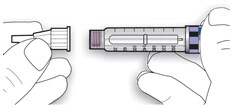
- If the needle is not kept straight while you attach it, it can damage the rubber seal and cause leakage, or break the needle.
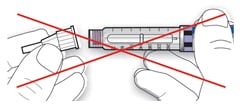
Step 3. Perform a Safety test
Always perform the safety test before each injection.
Performing the safety test ensures that you get an accurate dose by:
- ensuring that pen and needle work properly
- removing air bubbles
A. Select a dose of 2 units by turning the dosage selector.

B. Take off the outer needle cap and keep it to remove the used needle after injection. Take off the inner needle cap and discard it.

C. Hold the pen with the needle pointing upwards.
D. Tap the insulin reservoir so that any air bubbles rise up towards the needle.
E. Press the injection button all the way in. Check if insulin comes out of the needle tip.
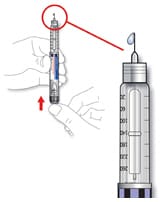
You may have to perform the safety test several times before insulin is seen.
- If no insulin comes out, check for air bubbles and repeat the safety test two more times to remove them.
- If still no insulin comes out, the needle may be blocked. Change the needle and try again.
- If no insulin comes out after changing the needle, your SoloStar may be damaged. Do not use this SoloStar.
Step 4. Select the dose
You can set the dose in steps of 1 unit, from a minimum of 1 unit to a maximum of 80 units. If you need a dose greater than 80 units, you should give it as two or more injections.
A. Check that the dose window shows “0” following the safety test.
B. Select your required dose (in the example below, the selected dose is 30 units). If you turn past your dose, you can turn back down.

- Do not push the injection button while turning, as insulin will come out.
- You cannot turn the dosage selector past the number of units left in the pen. Do not force the dosage selector to turn. In this case, either you can inject what is remaining in the pen and complete your dose with a new SoloStar or use a new SoloStar for your full dose.
Step 5. Inject the dose
A. Use the injection method as instructed by your healthcare professional.
B. Insert the needle into the skin.
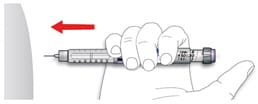
C. Deliver the dose by pressing the injection button in all the way. The number in the dose window will return to “0” as you inject.
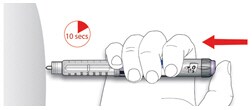
D. Keep the injection button pressed all the way in.
Slowly count to 10 before you withdraw the needle from the skin. This ensures that the full dose will be delivered.
Step 6. Remove and discard the needle
Always remove the needle after each injection and store SoloStar without a needle attached. This helps prevent:
- Contamination and/or infection.
- Entry of air into the insulin reservoir and leakage of insulin, which can cause inaccurate dosing.
A. Put the outer needle cap back on the needle, and use it to unscrew the needle from the pen. To reduce the risk of accidental needle injury, never replace the inner needle cap.
- If your injection is given by another person, special caution must be taken by this person when removing and disposing the needle. Follow recommended safety measures for removal and disposal of needles (e.g., a one-handed capping technique) in order to reduce the risk of accidental needle injury and transmission of infectious diseases.
B. Dispose of the needle safely. Used needles should be placed in sharps containers (such as red biohazard containers), hard plastic containers (such as detergent bottles), or metal containers (such as an empty coffee can). Such containers should be sealed and disposed of properly.
If you are giving an injection to another person, you should remove the needle in an approved manner to avoid needle-stick injuries.
C. Always put the pen cap back on the pen, then store the pen until your next injection.
Storage Instructions
Please check the leaflet for the insulin for complete instructions on how to store SoloStar.
If your SoloStar is in cool storage, take it out 1 to 2 hours before you inject to allow it to warm up. Cold insulin is more painful to inject.
Keep SoloStar out of the reach and sight of children.
Keep your SoloStar in cool storage (36°F–46°F [2°C–8°C]) until first use. Do not allow it to freeze. Do not put it next to the freezer compartment of your refrigerator or next to a freezer pack.
Once you take your SoloStar out of cool storage, for use or as a spare, you can use it for up to 28 days. During this time it can be safely kept at room temperature up to 86°F (30°C). Do not use it after this time.
SoloStar in use must not be stored in a refrigerator.
Do not use SoloStar after the expiration date printed on the label of the pen or on the carton.
Protect SoloStar from light.
Discard your used SoloStar as required by your local authorities.
Maintenance
Protect your SoloStar from dust and dirt.
You can clean the outside of your SoloStar by wiping it with a damp cloth.
Do not soak, wash, or lubricate the pen as this may damage it.
Your SoloStar is designed to work accurately and safely. It should be handled with care. Avoid situations where SoloStar might be damaged. If you are concerned that your SoloStar may be damaged, use a new one.
Instructions for use last revised 12/2020
Lantus (LAN-tus)
(insulin glargine injection) for subcutaneous use
10 mL Vial (100 Units/mL, U-100)
Read the Instructions for Use before you start taking Lantus and each time you get a new Lantus vial. There may be new information. This information does not take the place of talking to your healthcare provider about your medical condition or your treatment.
Do not share your Lantus syringes with other people even if the needle has been changed. You may give other people a serious infection, or get a serious infection from them.
Supplies needed to give your injection:
- a Lantus 10 mL vial
- a U-100 insulin syringe and needle
- 2 alcohol swabs
- 1 sharps container for throwing away used needles and syringes. See “Disposing of used needles and syringes” at the end of these instructions.
Preparing your Lantus dose:
- Wash your hands with soap and water or with alcohol.
- Check the Lantus label to make sure you are taking the right type of insulin. This is especially important if you use more than 1 type of insulin.
- Check the insulin to make sure it is clear and colorless. Do not use Lantus if it is colored or cloudy, or if you see particles in the solution.
- Do not use Lantus after the expiration date stamped on the label or 28 days after you first use it.
- Always use a syringe that is marked for U-100 insulin. If you use a syringe other than a U-100 insulin syringe, you may get the wrong dose of insulin.
- Always use a new syringe or needle for each injection. Do not re-use or share your syringes or needles with other people. You may give other people a serious infection or get a serious infection from them.
Step 1:
If you are using a new vial, remove the protective cap. Do not remove the stopper.
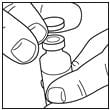
Step 2:
Wipe the top of the vial with an alcohol swab. You do not have to shake the vial of Lantus before use.
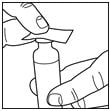
Step 3:
Draw air into the syringe equal to your insulin dose. Put the needle through the rubber top of the vial and push the plunger to inject the air into the vial.
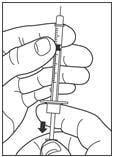 |
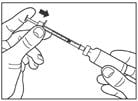 |
Step 4:
Leave the syringe in the vial and turn both upside down. Hold the syringe and vial firmly in one hand. Make sure the tip of the needle is in the insulin. With your free hand, pull the plunger to withdraw the correct dose into the syringe.
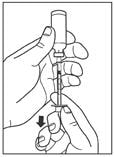
Step 5:
Before you take the needle out of the vial, check the syringe for air bubbles. If bubbles are in the syringe, hold the syringe straight up and tap the side of the syringe until the bubbles float to the top. Push the bubbles out with the plunger and draw insulin back in until you have the correct dose.
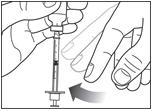
Step 6:
Remove the needle from the vial. Do not let the needle touch anything. You are now ready to inject.
Giving your Lantus injection:
- Inject your insulin exactly as your healthcare provider has shown you.
- Inject your insulin under the skin (subcutaneously) of your upper legs (thighs), upper arms, or stomach area (abdomen).
- Change (rotate) your injection sites within the area you choose for each dose to reduce your risk of getting lipodystrophy (pits in the skin or thickened skin) and localized cutaneous amyloidosis (skin with lumps) at the injection sites.
- Do not inject where the skin has pits, is thickened, or has lumps.
- Do not inject where the skin is tender, bruised, scaly or hard, or into scars or damaged skin.
Step 7:
Choosing your injection site: Lantus is injected under the skin (subcutaneously) of your upper arm, thigh, or stomach area (abdomen). Wipe the skin with an alcohol swab to clean the injection site. Let the injection site dry before you inject your dose.

Step 8:
- Pinch the skin.
- Insert the needle in the way your healthcare provider showed you.
- Release the skin.
- Slowly push in the plunger of the syringe all the way, making sure you have injected all the insulin.
- Leave the needle in the skin for about 10 seconds.
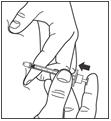
Step 9:
- Pull the needle straight out of your skin.
- Gently press the injection site for several seconds. Do not rub the area.
- Do not recap the used needle. Recapping the needle can lead to a needle stick injury.
Disposing of used needles and syringes:
- Put your used needles and syringes in a FDA-cleared sharps disposal container right away after use. Do not throw away (dispose of) loose needles and syringes in your household trash.
- If you do not have a FDA-cleared sharps container, you may use a household container that is:
- made of a heavy-duty plastic,
- can be closed with a tight-fitting, puncture-resistant lid, without sharps being able to come out,
- upright and stable during use,
- leak resistant, and
- properly labeled to warn of hazardous waste inside the container.
- When your sharps disposal container is almost full, you will need to follow your community guidelines for the right way to dispose of your sharps disposal container. There may be state or local laws about how you should throw away used needles and syringes. For more information about safe sharps disposal, and for specific information about sharps disposal in the state that you live in, go to the FDA’s website at: http://www.fda.gov/safesharpsdisposal.
- Do not dispose of your used sharps disposal container in your household trash unless your community guidelines permit this. Do not recycle your used sharps disposal container.
How should I store Lantus?
- Store unused Lantus vials in the refrigerator between 36°F to 46°F (2°C to 8°C).
- Store in-use (opened) Lantus vials in a refrigerator or at room temperature below 86°F (30°C).
- Do not freeze Lantus.
- Keep Lantus out of direct heat and light.
- If a vial has been frozen or overheated, throw it away.
- The Lantus vials you are using should be thrown away after 28 days, even if it still has insulin left in it.
SRC: NLM .
